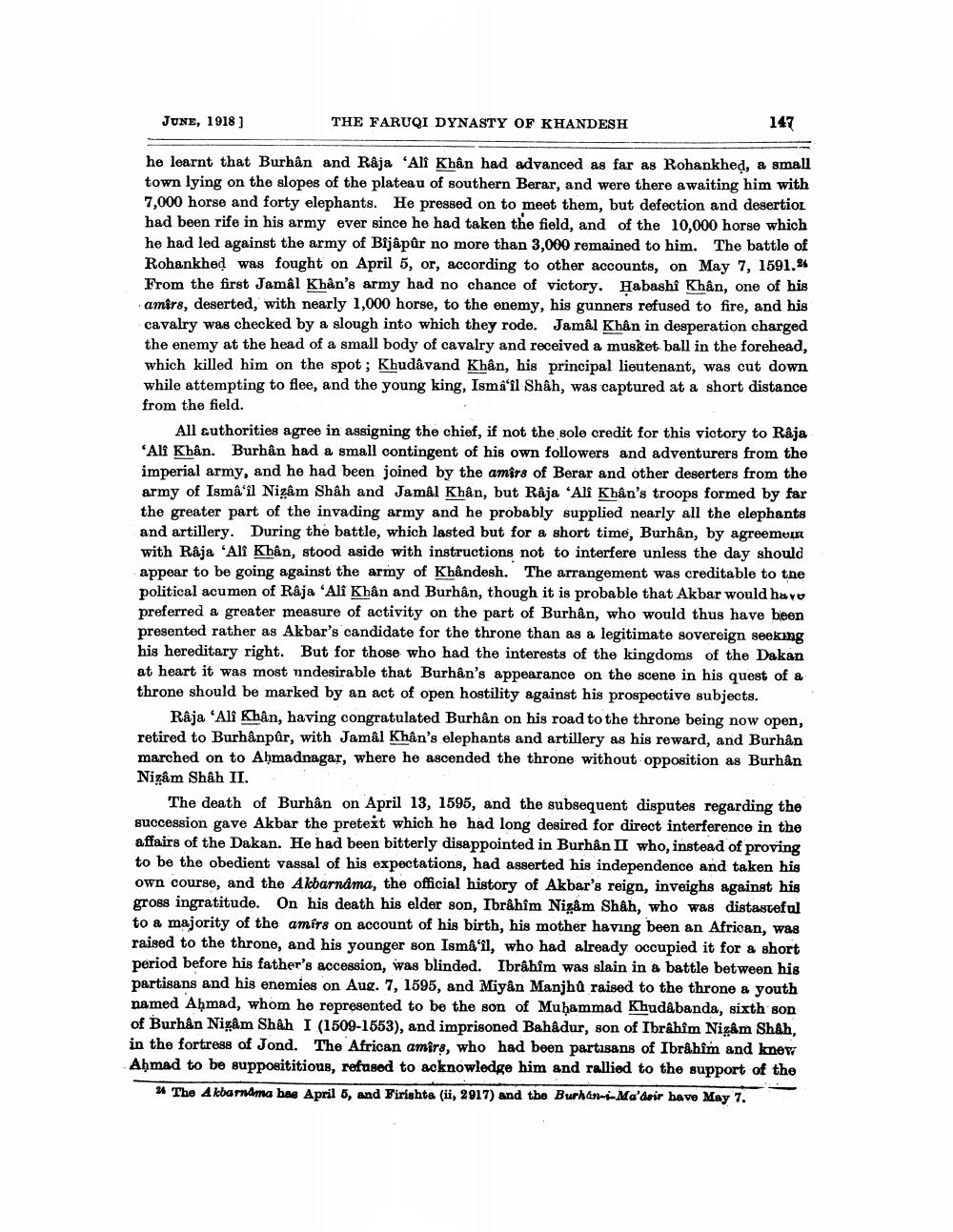________________
JUNE, 1918 ]
THE FARUQI DYNASTY OF KHANDESH
147
he learnt that Burhân and Raja 'Ali Khân had advanced as far as Rohankhed, a small town lying on the slopes of the plateau of southern Berar, and were there awaiting him with 7,000 horse and forty elephants. He pressed on to meet them, but defection and desertion had been rife in his army ever since he had taken the field, and of the 10,000 horse which he had led against the army of Bijapûr no more than 3,000 remained to him. The battle of Rohankhed was fought on April 5, or, according to other accounts, on May 7, 1591.24 From the first Jamal Khân's army had no chance of victory. Habashi Khan, one of his amirs, deserted, with nearly 1,000 horse, to the enemy, his gunners refused to fire, and his cavalry was checked by a slough into which they rode. Jamal Khân in desperation charged the enemy at the head of a small body of cavalry and received a musket ball in the forehead, which killed him on the spot; Khudâvand Khân, his principal lieutenant, was cut down while attempting to flee, and the young king, Isma'il Shah, was captured at a short distance from the field.
All authorities agree in assigning the chief, if not the sole credit for this victory to Raja 'Ali Khân. Burhan had a small contingent of his own followers and adventurers from the imperial army, and he had been joined by the amirs of Berar and other deserters from the army of Isma'il Nizam Shah and Jamal Khân, but Raja 'Ali Khan's troops formed by far the greater part of the invading army and he probably supplied nearly all the elephants and artillery. During the battle, which lasted but for a short time, Burhân, by agreemen with Raja 'Ali Khân, stood aside with instructions not to interfere unless the day should appear to be going against the army of Khândesh. The arrangement was creditable to the political acumen of Raja 'Ali Khan and Burhân, though it is probable that Akbar would have preferred a greater measure of activity on the part of Burhan, who would thus have been presented rather as Akbar's candidate for the throne than as a legitimate sovereign seeking his hereditary right. But for those who had the interests of the kingdoms of the Dakan at heart it was most undesirable that Burhan's appearance on the scene in his quest of a throne should be marked by an act of open hostility against his prospective subjects.
Râja 'Ali Khân, having congratulated Burhân on his road to the throne being now open, retired to Burhånpûr, with Jamal Khân's elephants and artillery as his reward, and Burhân marched on to Ahmadnagar, where he ascended the throne without opposition as Burhan Nizam Shah II.
The death of Burhân on April 13, 1595, and the subsequent disputes regarding the succession gave Akbar the pretext which he had long desired for direct interference in the affairs of the Dakan. He had been bitterly disappointed in Burhan II who, instead of proving to be the obedient vassal of his expectations, had asserted his independence and taken his own course, and the Akbarnama, the official history of Akbar's reign, inveighs against his gross ingratitude. On his death his elder son, Ibrâhîm Nizam Shah, who was distasteful to a majority of the amirs on account of his birth, his mother having been an African, was raised to the throne, and his younger son Isma'il, who had already occupied it for a short period before his father's accession, was blinded. Ibrahim was slain in a battle between his partisans and his enemies on Aug. 7, 1595, and Miyân Manjhů raised to the throne & youth named Ahmad, whom he represented to be the son of Muhammad Khudábanda, sixth son of Burhan Nizam Shah I (1509-1553), and imprisoned Bahadur, son of Ibrahim Nizam Shah, in the fortress of Jond. The African amîrs, who had been partisans of Ibrâhîm and knevi Aḥmad to be supposititious, refused to acknowledge him and rallied to the support of the
* The Albarnama has April 6, and Firishta (ii, 2917) and the Burhan-i-Ma'dir bave May 7.




